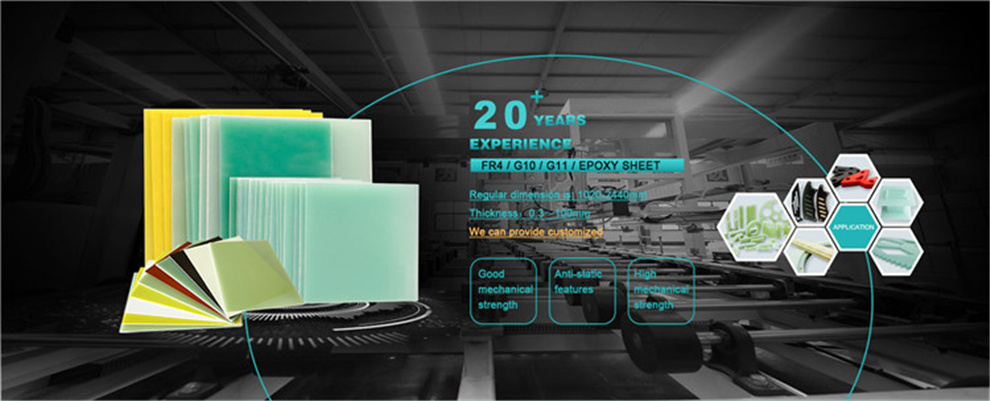Introduction
Laminates are composed of two or more layers of resin-impregnated fibers or fabrics that are laminated and thermally pressed into a whole. It can be a plate, tube, rod or other shape. Laminated products can be processed into various insulation and structural parts, which are widely used in motors, transformers, high and low voltage electrical appliances, electrical instruments and electronic equipment.
Laminated products use fibrous paper and cloth as the substrate, impregnated or coated with different adhesives, and then heat-pressed and rolled into a layered structure electrical insulating material. Substrates based on organic fibers include wood fiber paper, cotton fiber paper, cotton cloth, and synthetic fibers such as polyester and aromatic polyamide. The substrate of inorganic fiber includes alkali-free glass cloth, asbestos and so on. Commonly used adhesives are phenolic resin, epoxy resin, melamine resin, silicone resin, diphenyl ether and polyimide.

Classification:The performance of laminates depends on the substrate and adhesive as well as the molding process. According to its composition, characteristics and heat resistance, laminates can be divided into the following two types.
(1) Organic substrate laminates-wood pulp insulation paper, cotton fiber paper, cotton cloth, etc. as reinforcement materials. The long-term use temperature can reach 120℃, and synthetic fiber products have also been developed as reinforcing materials.
(2) Inorganic substrate laminates-inorganic glass fiber cloth, alkali-free glass fiber mat, etc. as reinforcement materials. The long-term use temperature is 130~180℃, and even higher temperatures can be reached, depending on the adhesive resin.
Laminated plastic products are classified into laminated plates, laminated tubes, laminated rods, and molded laminated products according to their shape and use. Copper-clad laminates for printed circuits and adhesive paper capacitor sleeve cores as capacitor sleeves for high-voltage electrical appliances are two types of special laminated plastic products.
Laminate:Including laminated papersheet, clothsheet, glass clothsheetand copper clad laminate.
①Laminated cardboard: It is made of insulating paper impregnated with synthetic resin glue and hot pressed. With good dielectric properties, mechanical properties and machining properties, it is suitable for various insulating structural parts in electrical equipment.
②Laminated fabricsheet: It is made by hot pressing cotton cloth impregnated with synthetic resin glue. It has good mechanical processing properties. Its hardness, splitting resistance and impact strength are better than that of papersheet, but its electrical properties are not as good as that of laminated papersheet. Its purpose is the same as that of laminated papersheet.
③Laminated glass clothsheet: It is made of alkali-free glass cloth impregnated with different synthetic resins by hot pressing. Its mechanical properties, heat resistance and water resistance are higher than those of laminated papersheetand clothsheet, but the bonding strength is slightly worse. The purpose is the same as that of laminated papersheet.
④Copper-clad laminate: It is made of alkali-free glass cloth or cotton fiber paper impregnated with phenolic resin or epoxy phenolic resin as the substrate, and electrolytic copper foil is applied on one or both sides of the substrate, and then formed by hot pressing. It has good mechanical properties and dielectric properties as well as high peel strength. Mainly used as a printed circuitsheetfor electronic equipment.
Rolled laminated products:including paper, cloth roll products and capacitive adhesive tape casing cores.
①Paper and cloth roll products: it is made of insulating wound paper, cotton cloth, glass cloth soaked or coated with synthetic resin, then rolled, impregnated and dried. Commonly used resins are phenolic resins, epoxy phenolic resins, and modified silicone resins. Paper and cloth rolls
The products can be made into rods, tubes or cylinders. Its dielectric properties and mechanical strength are higher than general plastic compression products, but lower than laminates and clothsheets. Mainly used as insulating structural parts.
②Capacitive tape paper sleeve core: It is made of winding paper coated with synthetic resin, then dried, hot rolled and heat treated. During rolling, a layer of aluminum foil is inserted as an electrode at regular intervals. It is a series capacitor with adhesive tape as the medium. It can be used as an insulator for the lead-out end of high-voltage transformers and switches.
③Molded laminated products: Insulating paper, cotton cloth, glass cloth, etc. impregnated with synthetic resin, and formed by hot pressing in a forming mold. It has rod-shaped molded products, V-rings and other special-shaped molded products. It has high mechanical properties, dielectric properties and moisture resistance. Mainly used as insulating structural parts for motors, electrical appliances and other equipment.
Development
With the development of the electrical industry, laminated plastic products with high insulation, high strength, high temperature resistance and adaptation to various use environments have appeared one after another. Copper clad laminates for printed circuits have also developed rapidly due to the needs of the electronics industry. my country's electrical and electronic laminates have gradually developed after liberation. my country's thermosetting laminate products have formed a relatively complete series.
In recent years, with the rapid development of the solar cell industry, solar cell laminates have been increasingly produced and applied to many aspects of life, and their production processes have been continuously improved. Research by Huang Hao et al. found that even if the solar cell laminate is deformed to varying degrees under mechanical load, it does not necessarily have a greater impact on the internal performance of the battery. Under the condition of using the given module size data and withstanding the mechanical static load of 5400 Pa specified by the IEC61215 standard, the deformation of the module will not cause performance problems such as cell cracks and splits inside the module.
Contact Us
JY Machinery has been providing top-flight plastics and composite machining. Contact us for more information or get a quote on thermoset & thermoplastic materials machining for your project.
